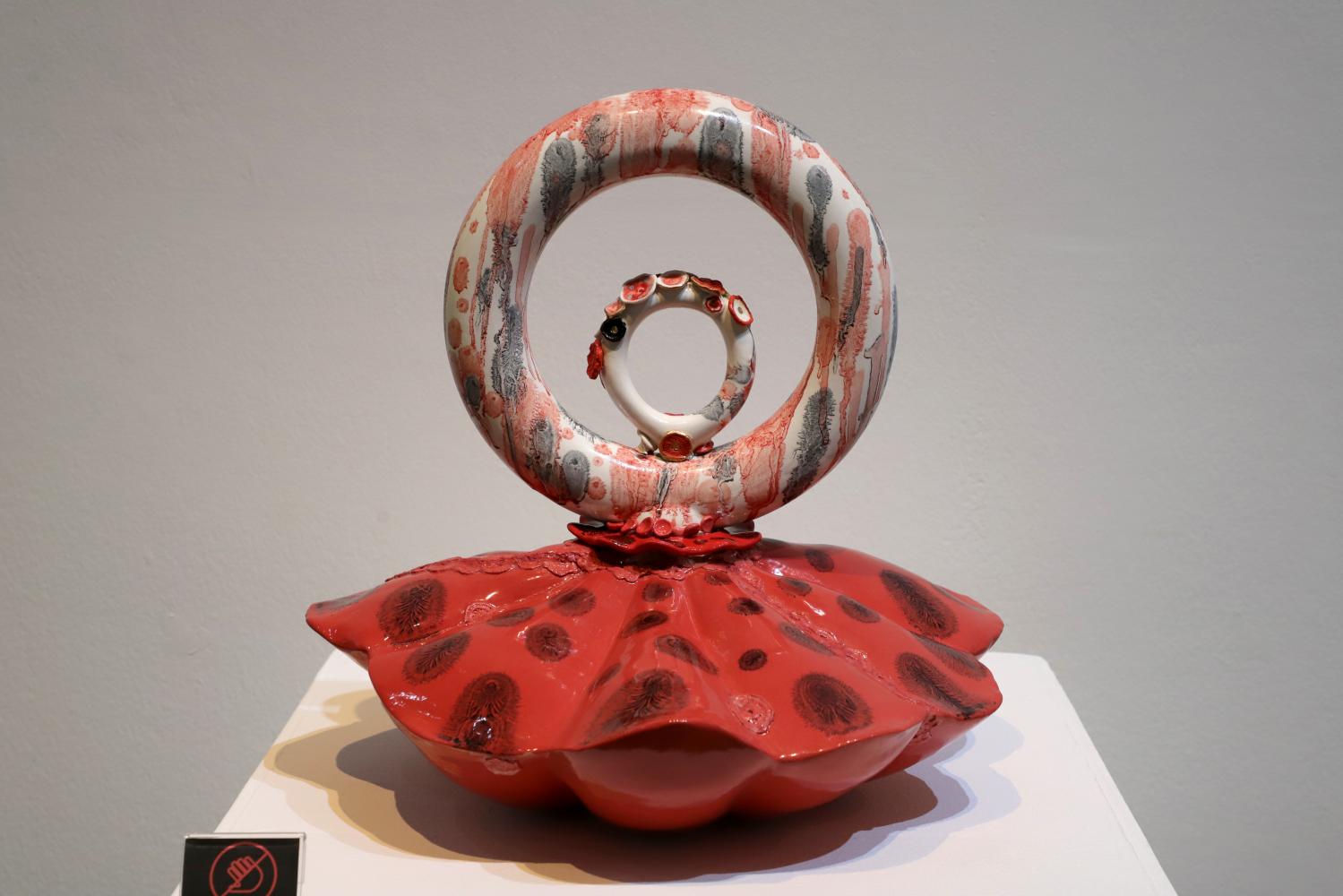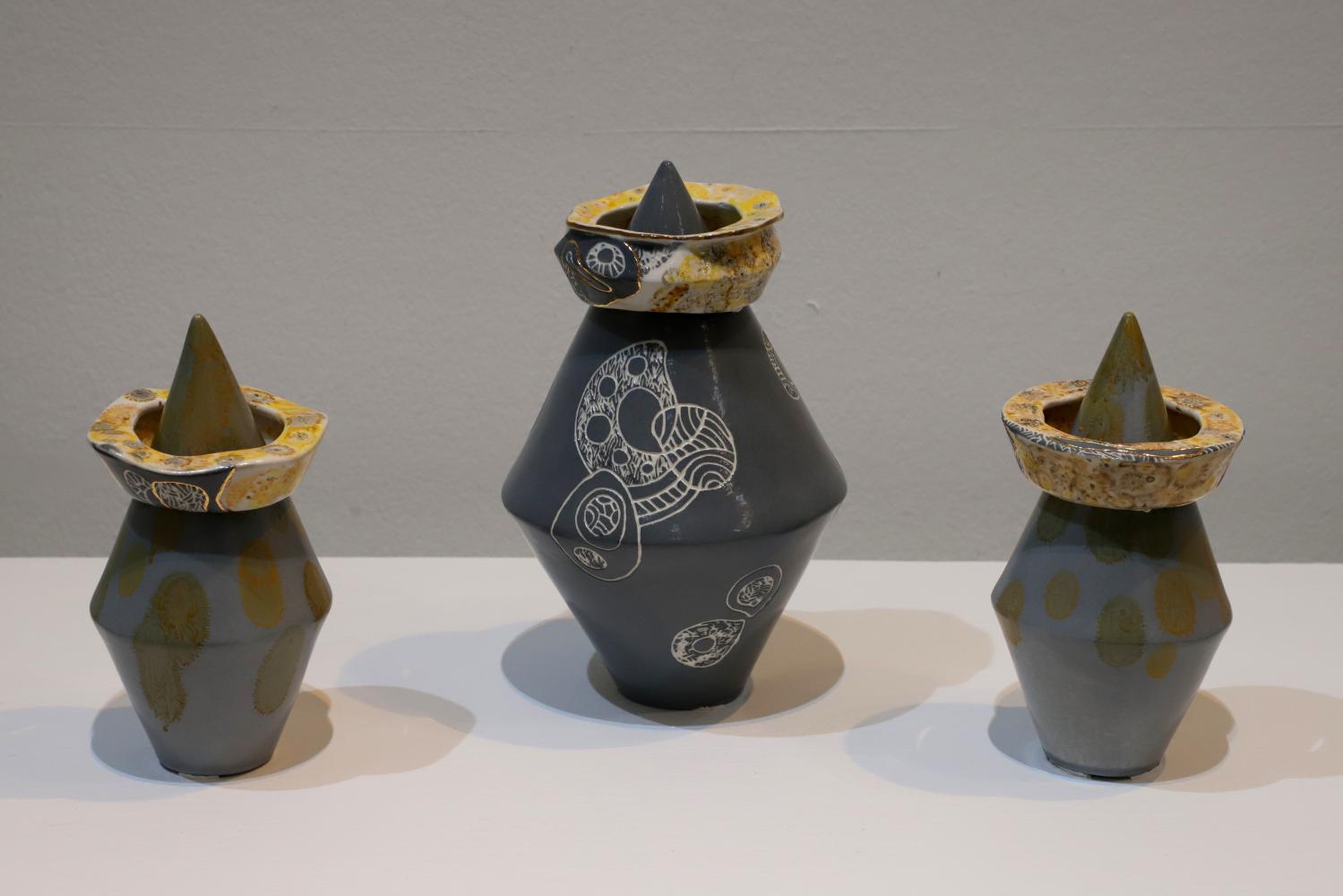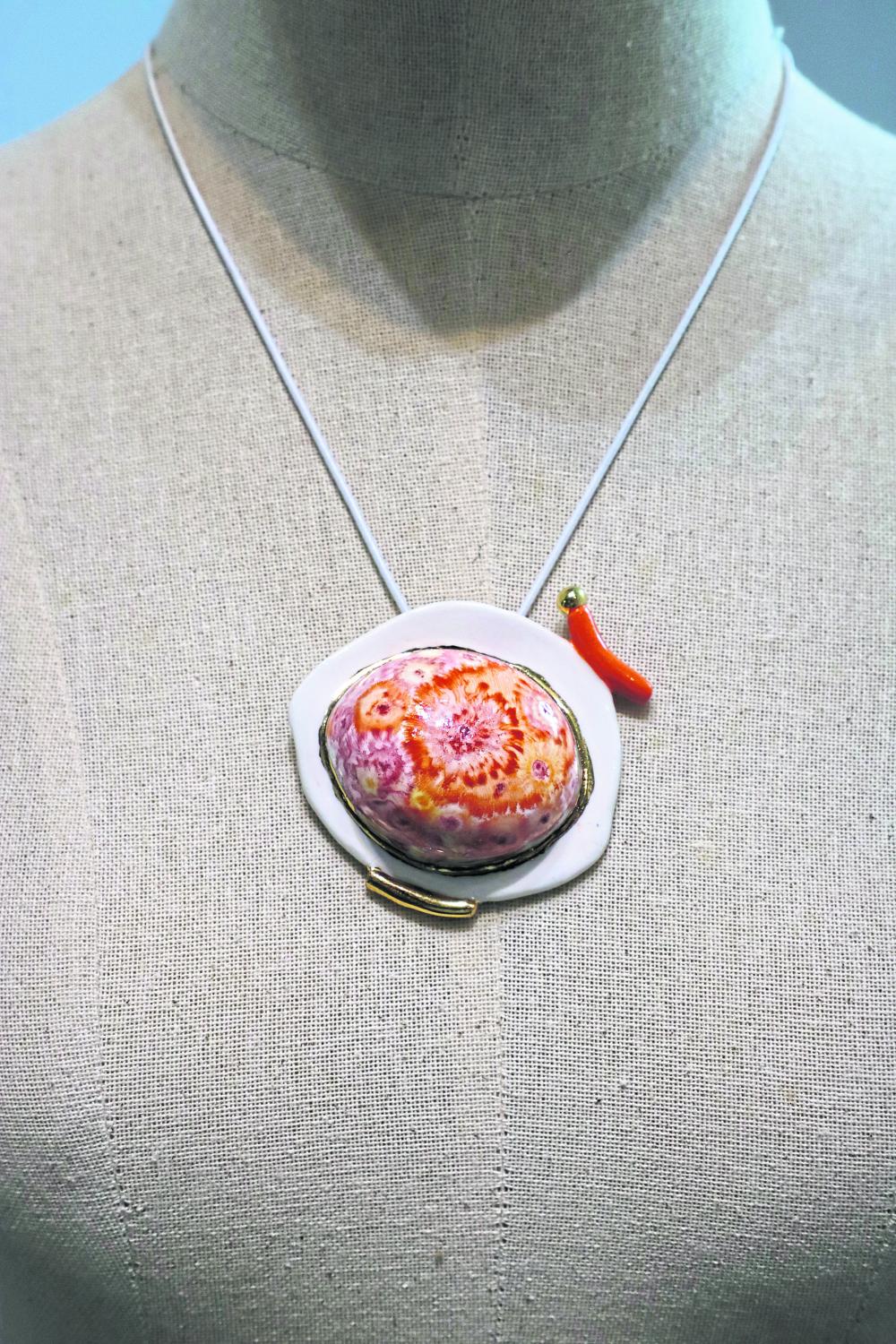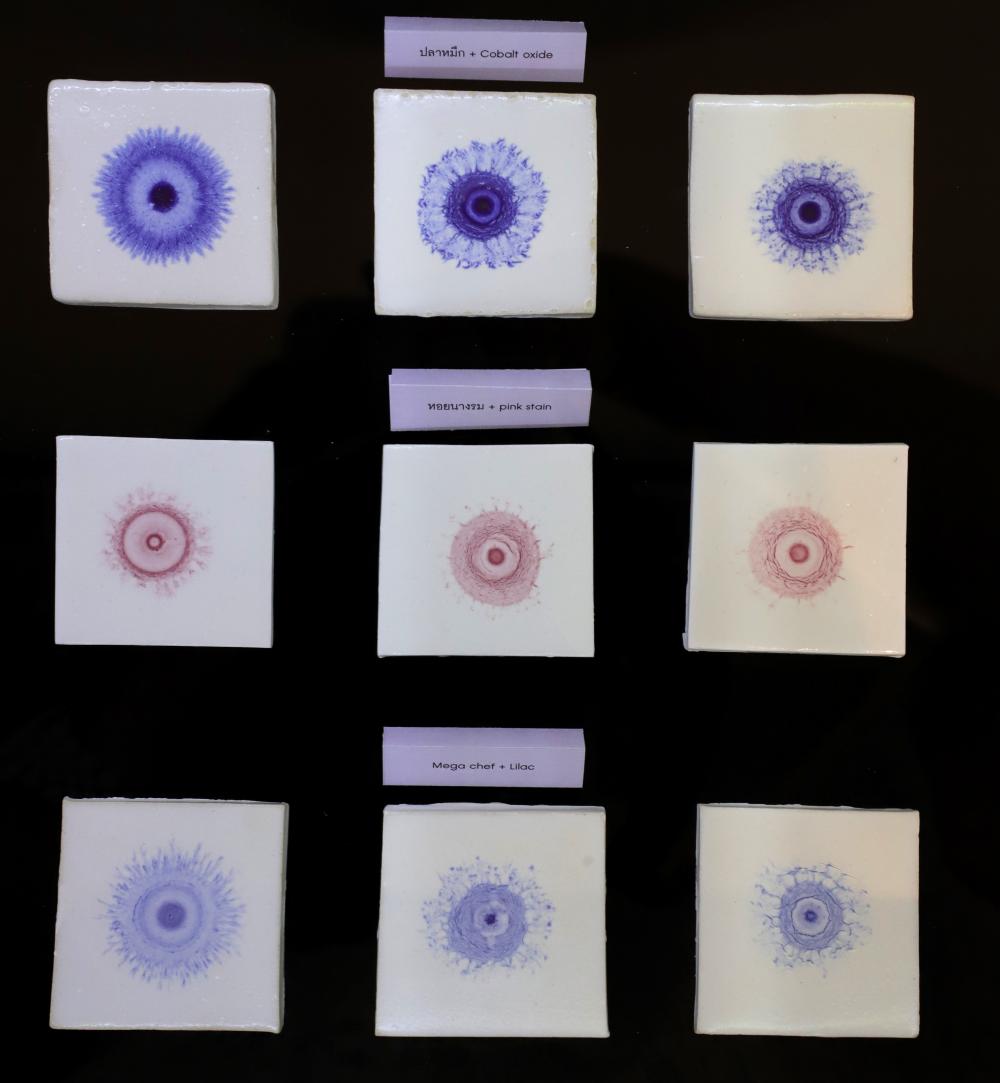Assoc Prof Sukumarl Sarakasetrin, ceramist and lecturer at the Faculty of Fine and Applied Arts, Chulalongkorn University, took an interest in mochaware -- a type of household pottery first produced in the UK -- having been struck by its complex patterns resembling those seen on agate.
The dendritic patterns of English mochaware were created by mixing colour oxide with vinegar, coffee or simmered tobacco juice and dropping the mixture on the slip (a liquid mixture of clay and water).
While writing her book Pottery: Mochaware Style Design, Sukumarl tried to create mochaware patterns by using different substances. During the process, she discovered that fish sauce can create intriguing results.
"I became interested in mochaware due to its natural patterns and the fact that it commands such high prices of over 20,000 baht. When I was almost finished writing the book, I saw a bottle of fish sauce nearby, so I decided to mix it with colour oxide and discovered that the combination creates the most delicate and sharpest lines," said Sukumarl.

Assoc Prof Sukumarl Sarakasetrin.
"After that, I proposed the research project 'Ceramic Design And Decoration Innovation From Fish Sauce' and requested funding from the National Research Council of Thailand. The aesthetic patterns formed by fish sauce do not look like dendrites since the splashes are balanced on both sides and have intricate layers in the middle."
During research, Sukumarl tested more than 10 brands of fish sauce. She also tested other substances such as drinking yoghurt, effective microorganisms liquid, mouthwash, coffee and soy sauce. Her finding was that fish sauce creates the most delicate and sharpest lines at the lowest cost and is convenient to use.
"The UK's process of using tobacco juice is more complicated because the substance must be simmered, but I didn't know exactly how strong the fire should be. Another process called for coffee as an ingredient, but no specific amount of coffee and water was indicated. For fish sauce, I just opened a bottle and mixed the sauce into oxides and stains [ceramic pigments] and dropped them into the slip. Fish sauce is available at a reasonable price and is easy to find. Soy sauce also creates sharp line patterns, but its price is higher than fish sauce."
The results obtained from using fish sauce make it a good option for ceramists wanting to try a new substance. However, some people may wonder about the smell because everyone knows that fish sauce is pungent.
"At the beginning I was affected by the odour, but I later got used to it... and the smell of the fish sauce goes away after firing the ceramic. And one of the best things about fish sauce is that it doesn't go off. I mixed fish sauce with ceramic pigments in colour mixing bowls and left them for a month. When I checked on the bowls, the fish sauce was not spoilt at all. Other ingredients like beer got mouldy and vinegar retained an extremely strong smell."
Sukumarl also created a ceramic exhibition, "Hidden Gems", as part of her research project. With support from the Office of Art and Culture, Chulalongkorn University, the collection is exhibited at Chula Museum. Ceramic sculptures in the collection were given the names of gems such as ruby, sapphire and emerald.
"Fish sauce is a valued ingredient that can be found in every household, so it can be considered a household gem. My inspiration for 'Hidden Gems' was based on gem colours such as red ruby, blue sapphire, green emerald and black onyx as well as geometric forms. Normally, mochaware is kitchenware. However, I wanted to create something different, so I designed sculptures attached with ornamental pieces. Each ornament can be separated from the main sculpture. Without the ornament, the main sculpture still maintains its aesthetic appeal."

Ceramic works by Assoc Prof Sukumarl Sarakasetrin.
In addition to the balanced proportions and beautiful splashes obtained from dropping fish sauce on slip, Sukumarl discovered that dropping the condiment on bone china slip creates a well-distributed pattern with sharp lines. The ceramist also found that spraying alcohol while the slip is wet creates a unique net-like pattern. To save production costs, she later experimented with a single firing instead of the usual two. The result was positive.
"The sculptures came out with fine, sharp and clear patterns. Many pieces for 'Hidden Gems' were produced by single firing. This saves a lot of production and energy expenses," she said.
The ceramist was curious to know why the process resulted in such beautiful splashes on the sculptures. She did some research and learned that the way the patterns spread out can be explained by what's known as the Marangoni effect relating to different surface tension gradients, in this case a difference between the fish sauce and the slip.
Sukumarl has been passionate about ceramics since she was an undergraduate student at the Faculty of Education, Chulalongkorn University. After taking a couple of ceramic courses by Somthavil Urassayanan, the national artist, she realised that making ceramics was her true passion. She went on to earn a master's degree in ceramics and metalsmithing from Illinois State university
While working as a lecturer of creative arts at the Faculty of Fine and Applied Arts, Chulalongkorn University, Sukumarl created many beautiful ceramic collections which have exhibited in several countries including Turkey, USA, China and Croatia.

"I am impressed that both local and international ceramic communities have solid relationships and always support each other. I get a warm feeling knowing I have friends all over the world."
After almost 30 years of working with ceramics, Sukumarl still feels great excitement and energy when creating new pieces.
"Making ceramics makes me energetic. I can work for 10 hours straight without eating. I still feel so excited to see my finished work come out of the kiln."
She hopes those visiting the exhibition "Hidden Gems" will recognise a new kind of ceramic design. She likewise is hopeful that people in the ceramics industry will try using fish sauce in their own work.
"A mochaware mug costs 20,000 baht or more. If people in the ceramics industry want to create mochaware, they can use fish sauce to keep production costs down. For 'Hidden Gems', I've also designed jewellery with silver- and gold-coloured edges. These accents cost a lot. However, by using fish sauce, ceramists can cut down costs and still add the silver and gold colours to the pieces. As a result, we can add more value to ceramics and sell them at higher prices," said Sukumarl.
"Hidden Gems" runs at Chula Museum until March 31. Admission is free. For more information, visit facebook.com/cuartculture or call 02-218-3621.

A piece with gold-coloured edge.

More than 10 brands of fish sauce were tested.

